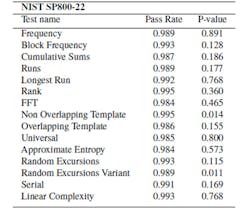Silicon-on-Insulator Electro-Optics Yields Advanced Random Number Generator
The search for a better, smaller, faster “true” random number generator—increasingly needed for strong cryptography and security—has fascinated technologists for many years, as they seek genuine probabilistic sources rather than those with even a tiny hint of determinism. This endeavor generally begins with an all-natural, physics-based phenomenon that defies any possibility of prediction.
In one of the most recent efforts, an international team of researchers, led by quantum-technology experts from the University of Bristol (U.K.), have developed a chip-based device that can be used to generate quantum-based random numbers at gigabit-per-second speeds (Fig. 1).
1. The chip, placed next to a penny coin, contains nearly all of the optical components needed to generate quantum-based random numbers at high speed. (Image source: Francesco Raffaelli, University of Bristol)
They have demonstrated a silicon-on-insulator (SOI) quantum random number generator (QRNG) that uses phase fluctuations of the output a laser diode, where single photons are randomly emitted and thus generate an electrical signal that’s impossible to predict. All optical components (except the laser diode) and photodiodes are integrated onto a single monolithic device, fabricated by IMEC using industry-standard processing techniques. The laser diode is coupled to the circuit via an optical fiber.
The optical functions occupied less than 1 mm2 and were integrated onto a 2.5- × 2.5-mm SOI chip that was embedded and wirebonded to a 4- × 8-cm printed circuit board containing a transimpedance amplifier (TIA) and voltage supply for the photodiodes. Finally, the system was placed within a Faraday cage to reduce the RF noise pickup.
Their detailed paper “Generation of random numbers by measuring phase fluctuations from a laser diode with a silicon-on-insulator chip,” published in Optics Express (a journal of The Optical Society of America’s), explains the deep-physics theory, what they did, as well as how and why it’s much smaller and lower power than previous approaches that used free-space and fiber optics.
In this implementation, the thermally stabilized laser diode is operated just above its threshold voltage. These spontaneous emissions are characterized by random phase fluctuations, which the system exploits to generate true random numbers. The random photon output is sent to a polarization controller that optimizes the coupling of the optical beam. A beamsplitter diverts a portion of the photon output to be used for calibration, characterization, and real-time monitoring of coupling losses using a test waveguide and power meter (Fig. 2).
2. In the quantum RNG, a temperature-stabilized laser diode is operated just above its active-output threshold. A small portion of its output is coupled into a test waveguide for monitoring by a photodiode, while the rest of light is sent a cascade of tuned interferometers. Their output is captured by a second photodiode connected to a transimpedance amplifier, which converts the light intensity fluctuations into voltage fluctuations that are digitalized by the oscilloscope to generate random bits. (Image source: University of Bristol)
Two germanium photodiodes are used, with one to monitor the optical power and vary the phase of the integrated phase-shifters through heater drivers controlled via a computer. The output of the second photodiode is converted into a voltage by a custom, high-speed, low-noise TIA. The resulting voltage signal is digitized by a gigahertz-bandwidth Agilent oscilloscope, while the captured voltage “spikes” are extensively post-processed to extract the random bit.
The quality of the random-number results was assessed using the statistical test suite provided by the National Institute of Standards and Technology (NIST SP 800-22) (see table). To pass this suite, the “pass rate” must be above 0.98 for each type of test (column II) and the P-values (which refer to the uniformity test on the distributions) must be above 0.01 (column III). This device met these criteria and several others.
The researchers maintain that they achieved their high rates of QRNG results at sub-milliwatt optical power—an order of magnitude lower the previous QRNG in a SOI device—along with very high phase stability, greatly reducing the need for active stabilization and associated dissipation. The integrated laser source provides an advantage in term of compactness and scalability, and doesn’t require RF modulation of laser diodes, thus simplifying the electronic design.




